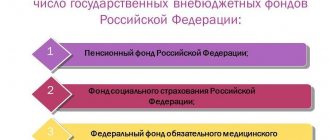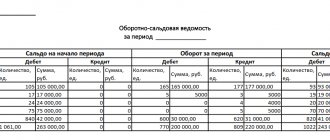What it is
The main activity of the company brings it not only income, but also requires expenses for maintenance and development. An increase in economic benefits is considered income, and the occurrence of additional obligations is considered an expense. In accounting, all these transactions are reflected in account 90 “Sales”. But there are also revenues and expenses not related to the main activity that also need to be taken into account. For these purposes, according to Order of the Ministry of Finance No. 94N, 91 accounting accounts “Other income and expenses” were opened. It relates to financial performance and is intended to reflect the positive and negative results of other activities of the enterprise. After the latest revision of the Chart of Accounts, it performs two roles:
Profit and loss
- Serves to reflect the result of non-core economic activities.
- It is collective and serves to collect and store information on transactions not related to the main type of activity.
Role in accounting
"Regular" accounting
Information about “ordinary” income and expenses, as well as the financial result for them, is reflected in account 90 “Sales” in correspondence with the debit of account 62 “Settlements with buyers and customers”. Subaccount 90-1 “Revenue” is intended for revenue accounting.
EXAMPLE An organization received revenue in the amount of 1,770,000 rubles (including VAT - 270,000 rubles).
The cost of goods sold was 900,000 rubles, the cost of their sale was 255,000 rubles. The following entries must be made in accounting: DEBIT 62 CREDIT 90-1
– 1,770,000 rubles – revenue from the sale of goods is reflected;
DEBIT 90-3 CREDIT 68, subaccount “Calculations for VAT”
– 270,000 rubles – VAT charged;
DEBIT 90-2 CREDIT 41
– 900,000 rubles – cost of goods sold is written off;
DEBIT 90-2 CREDIT 44
– 255,000 rubles – sales expenses are written off;
DEBIT 90-9 CREDIT 99
– 345,000 rubles (1,770,000 – 270,000 – 900,000 – 255,000) – profit from sales is reflected.
What is it used for?
All transactions that generate income or expenses that are not related to the main activity of the company are reflected in the accounting department in subaccounts 91. The Accounting Regulations (PBU) 9/99 oblige two types of income and expenses to be attributed to them:
- operational, are directly related to the economic activities of the enterprise, but are not the goal;
- non-operating, formed due to the consequences of the economic activities of the organization.
Additional Information! They are shown separately in the financial statements.
Expenses
Conditions of recognition
Paragraph 12 of PBU 9/99 establishes five conditions, under the simultaneous fulfillment of which revenue is recognized in accounting: the organization has the right to receive it, the company’s revenue is obtained from a specific agreement or is confirmed in another appropriate manner; its amount can be determined; there is confidence that as a result of a specific transaction there will be an increase in the economic benefits of the organization; the right of ownership (possession, use and disposal) of the product (goods) has passed from the company to the buyer or the work has been accepted by the customer (service provided); the costs of the operation can be determined.
If at least one of the above conditions is not met for the money and other assets received by the company, not revenue is recognized in accounting, but accounts payable.
Amounts from the provision for temporary use of company assets for a fee, rights arising from patents for inventions, industrial designs and other types of intellectual property and from participation in the authorized capital of other organizations are recognized as income if only three conditions are simultaneously met: the company has the right to receive proceeds , arising from a specific contract or otherwise confirmed in an appropriate manner; the amount of earnings can be determined; there is confidence that a particular transaction will result in an increase in the economic benefits of the organization.
Account characteristics
During the reporting period, account 91 and its subaccounts collect data on transactions related to other types of activities that form its characteristics.
Active or passive
You can easily answer question 91 whether an account is active or passive; just look at how accounting transactions are reflected on it. Receipts are posted as a credit and expenses as a debit. Thus, it is active-passive in accounting. At the end of the reporting month, it must be closed; to do this, all balances must be transferred. At the beginning of a new period, the balance should be zero.
What does debit and credit show?
The following transactions will be taken into account on the debit of account 91:
- Expenses associated with the provision of temporary use of company assets, securities, provision of patents and rights to inventions, as well as participation in the authorized capital of third-party enterprises.
- The identified residual value of assets, as well as the actual cost subject to write-off.
- Costs incurred in a foreign currency other than the Russian ruble upon the sale, write-off or disposal of the company's assets.
- Costs associated with the manipulation of the old one.
- Interest paid to lenders for borrowing money.
- Expenses for services provided by credit companies.
- Payment of penalties, penalties, and fines to suppliers for violation of contract terms by the company.
- Costs associated with mothballed production facilities.
- Compensation to the injured party for losses caused by the company.
- Losses incurred from previous years that are recognized in the current reporting period.
- Transfer of funds to reserves due to a decrease in the value of securities, material assets, and doubtful debts.
- Write-off of irrecoverable receivables upon expiration of the statute of limitations.
- Exchange differences resulting from currency exchange.
- Legal costs.
Securities
Credit account 91 will show the following transactions:
- Income from the temporary use of enterprise assets.
- Profit received from intellectual property: patents for inventions, industrial designs.
- Receipts from securities and participation in the authorized capitals of third-party companies.
- Income from simple partnership agreements.
- Profit from the sale or write-off of fixed assets and other assets of the enterprise, received not in Russian currency.
- Income from old transactions.
- Interest on cash loans issued to third parties.
- Receipts from suppliers of penalties, fines, penalties for improper compliance with the terms of contracts.
- Receiving assets for free use.
- Receipts for compensation of losses from third parties.
- Income from profits of previous years received in the current reporting period.
- Accounts payable that are not subject to payment after the expiration of the statute of limitations.
- Exchange differences resulting from currency exchange.
Note! All transactions relating to other expenses and income are contained in Order of the Ministry of Finance of the Russian Federation No. 115N dated September 18, 2006.
Accounting for financial results from current activities and other income and expenses.
⇐ PreviousPage 11 of 16Next ⇒When accounting for income and expenses, you should be guided by:
“Instructions for accounting of income and expenses” Ministry of Finance, 09/30/2011 N 102 (as amended on 12/14/2012 No. 74).
Income and expenses, depending on their nature, conditions of implementation and areas of activity of the organization, are divided into:
· income and expenses for current activities;
· income and expenses from investment activities;
· income and expenses from financial activities;
· other income and expenses.
Income from current activities is revenue from the sale of products, goods, works, services, as well as other income from current activities.
Expenses for current activities represent the part of the organization's costs related to income from current activities received by the organization in the reporting period. Operating expenses include expenses that form:
· cost of products sold, goods, works, services;
· administrative expenses;
· sales costs;
· other expenses for current activities.
Cost of goods sold,
goods, works, services in an organization
carrying out industrial and other production activities, includes direct costs and distributed variable indirect costs directly related to the production of products, performance of works, provision of services related to sold products, works, services.
Direct costs include direct material costs and direct labor costs.
Direct material costs include the cost of consumed raw materials and materials that form the basis of manufactured products, purchased semi-finished products, components and other materials, the cost of which can be directly included in the cost of a certain type of product, work, or service.
Direct labor costs include the costs of wages and other payments to employees involved in the production of products, performance of work, provision of services, which can be directly included in the cost of a certain type of product, work, service, as well as the amount of mandatory deductions established legislation, from the specified payments.
The distributed variable indirect costs include indirect general production costs, the value of which depends on the volume of products produced, work performed, and services provided.
Administrative expenses include in an organization engaged in industrial and other production activities - conditionally constant indirect costs associated with managing the organization, taken into account in account 26 “General business expenses” and written off in full when determining financial results in the debit of account 90 “Revenues and expenses for current activities" (subaccount 90-5 "Administrative expenses").
In an organization engaged in industrial and other production activities, conditionally constant indirect overhead costs are included in the cost of goods sold, work, services, or are classified as administrative expenses in the manner established by the organization's accounting policy.
If these costs are included in the cost of sold products, works, services, they are written off to the debit of accounts 20 “Main production”, 23 “Auxiliary production” and other accounts, and if they relate to administrative expenses, they are written off to the debit of account 90 “Revenue and expenses for current activities" (subaccount 90-5 "Administrative expenses").
Sales expenses include: in an organization engaged in industrial and other production activities - sales expenses accounted for in account 44 “Sales expenses” and written off in full when determining financial results to the debit of account 90 “Revenues and expenses for the current activities" (subaccount 90-6 "Sales expenses");
Other income and expenses for current activities , recorded on account 90 “Income and expenses for current activities” (subaccounts 90-7 “Other income for current activities”, 90-10 “Other expenses for current activities”) include:
income and expenses associated with the sale and other disposal of inventories (except for products, goods) and cash;
amount of surplus inventory, cash
identified as a result of the inventory;
the cost of inventories, cash , work performed, services provided, received or transferred free of charge;
income associated with government support aimed at purchasing inventories, paying for work performed, services provided, and financing current expenses;
income and expenses from the assignment of the right of claim;
the amount of shortages and losses from damage to inventories and funds;
the amounts of reserves created to reduce the value of inventories and the recoverable amounts of these reserves;
the amounts of reserves created for doubtful debts and the recoverable amounts of these reserves;
the amount of reserves created for the depreciation of short-term financial investments and the recoverable amounts of these reserves (if the organization is a professional participant in the securities market);
costs of canceled production orders;
expenses of service industries and farms;
financial assistance to employees of the organization, remuneration based on the results of work for the year;
losses from downtime due to external reasons that are not compensated by the guilty parties ;
fines, penalties for payments to the budget, for calculations for social insurance and security;
penalties (fines, penalties) and other types of sanctions for violation of the terms of contracts, awarded by the court or recognized by the debtor, due to be received;
penalties (fines, penalties ) and other types of sanctions for violation of contract terms, awarded by the court or recognized by the organization, subject to payment;
expenses associated with the consideration of cases in courts;
income (expenses) of previous years for current activities identified in the reporting period;
other income and expenses for current activities.
The composition of income and expenses for investment activities accounted for in account 91 “Other income and expenses” includes:
income and expenses associated with the sale and other disposal of investment assets, sale (repayment) of financial investments;
the amount of surplus investment assets identified as a result of the inventory;
amounts of shortages and losses from damage to investment assets;
income and expenses associated with participation in the authorized funds of other organizations;
income and expenses under joint activity agreements;
income and expenses on financial investments in debt securities of other organizations (if the organization is not a professional participant in the securities market);
the amount of reserves created for the depreciation of short-term financial investments and the recoverable amounts of these reserves (if the organization is not a professional participant in the securities market);
the amount of change in the value of investment assets as a result of revaluation, impairment, recognized as income (expenses) in accordance with the law;
income related to government support aimed at acquiring investment assets;
the value of investment assets received or transferred free of charge;
income and expenses associated with the provision of temporary use (temporary possession and use) of investment real estate;
interest receivable;
profit (loss) of previous years on investment activities identified in the reporting period;
other income and expenses from investment activities.
The composition of income and expenses for financial activities recorded in account 91 “Other income and expenses” includes:
interest payable for the organization's use of credits and loans (with the exception of interest on credits and loans, which are included in the cost of investment assets in accordance with the law);
the difference between the actual costs of repurchasing shares and their par value (in case of cancellation of repurchased shares) or the cost at which these shares were sold to third parties (in case of subsequent sale of repurchased shares);
expenses associated with obtaining for temporary use (temporary possession and use) of property under a financial lease (leasing) agreement (if leasing activity is not a current activity);
income and expenses associated with the issue, placement, circulation and redemption of debt securities of its own issue (if the organization is not a professional participant in the securities market);
exchange rate differences arising from the translation of assets and liabilities denominated in foreign currency, except in cases established by law;
differences arising when repaying an obligation in a currency other than the currency of the obligation, except for cases established by law;
income (expenses) of previous years from financial activities identified in the reporting period;
other income and expenses from financial activities.
Other income and expenses recorded on account 91 “Other income and expenses” include income and expenses related to emergency situations, other income and expenses not related to current, investment and financial activities.
On January 1, 2012, a new edition of the Chart of Accounts came into effect. In order to bring national accounting closer to International Financial Reporting Standards, accounting for financial results from current activities (account 90) and financial results from other income and expenses (account 91) is divided.
Account 91 “Other income and expenses” is intended to summarize information on other income and expenses of the reporting period that are not directly related to the current activities of the organization, including investment and financial activities.
Sub-accounts can be opened to account 91 “Other income and expenses”:
91-1 “Other income”;
91-2 “Value added tax”;
91-3 “Other taxes and fees calculated from other income”;
91-4 “Other expenses”;
91-5 “Balance of other income and expenses.”
Entries for subaccounts 91-1 - 91-4 are made cumulatively during the reporting year. By comparing debit turnover in subaccounts 91-2, 91-3, 91-4 and credit turnover in subaccount 91-1, the balance of other income and expenses for the reporting period is determined, which is reflected in the debit (credit) of account 99 “Profit and Loss” and credit (debit) of subaccount 91-5 “Balance of other income and expenses.” Account 91 “Other income and expenses” does not have a balance at the reporting date.
At the end of the reporting year, all sub-accounts opened to account 91 “Other income and expenses”, except for sub-account 91-5 “Balance of other income and expenses”, are closed with internal entries to sub-account 91-5 “Balance of other income and expenses”.
Analytical accounting for account 91 “Other income and expenses” is carried out by type of other income and expenses and (or) in another manner established by the accounting policy of the organization. Analytical accounting of other income and expenses related to the same business transaction should provide the ability to identify the financial result for this operation.
⇐ Previous11Next ⇒
Didn't find what you were looking for? Use Google search on the site:
How to close an account
The law obliges organizations to close monthly accounts that collect information about income and expenses from the company’s main and secondary activities. Accounting account 91 allows you to do this in several stages:
- The difference between debit and credit is transferred monthly to subaccount 91.09, and the indicators are also transferred to account 99 “Profits and losses” at a synthetic level.
- At the end of the annual reporting period, analytical levels should be closed and the balance sheet reformed.
In order to correctly close account 91 at the end of the month, you first need to calculate the balance amount for all subaccounts in order to have a complete picture of what will be included in the next reporting period. To identify the interim financial result, you need to compare the results for the debit of subaccount 91.2 and the credit of subaccount 91.1. The resulting debit balance indicates losses, while the credit balance indicates the company’s profit in the reporting period.
What entries will the accountant make to close account 91:
- Dt91.1 - Kt91.9 - the income part is closed.
- Dt91.9 - Kt91.2 - the consumable part is closed.
- Dt91.09 - Kt99 - profit taken into account.
- Dt99 - Kt91.09 - loss taken into account.
After the monthly closure of the synthetic account level 91, analytical information continues to be collected on it throughout the year, reflecting:
- Types of income and expenses.
- Expenditures.
- Divisions.
In order to reset all analytical balances on account 91, at the end of the year the enterprise must undergo a balance sheet reformation. What entries will the accountant make to close 91 accounts at the end of the year:
- write-off of the balance of other expenses is expressed by the following accounting entries Dt91.01 - Kt91.09;
- expenses Dt91.09 - Kt91.2 are closed.
After this, all that remains is to close the resulting total to account 99 “Profits and losses”. Depending on the financial result, one of two postings will be made:
- Dt91.9 - Kt99 - reflects the profit generated at the end of the reporting year.
- Dt99 - K91.9 - a loss was recorded that was not received from the main activity.
All transactions on account 91 must be documented. What documents may regulatory authorities request:
- Invoices.
- Accounting certificates.
- Acceptance and transfer acts.
- Inventory records.
- Depreciation statements.
Important! If you do not close account 91 and transfer analytical and synthetic accounting data from it to account 99, then its balance at the end of the year will be reflected in the balance sheet. As a result, the accountant will not be able to formulate the correct result of the company’s financial activities.
Accountant closes the month
Existing subaccounts
Account 91 has several mandatory subaccounts in the following groups of income and expenses:
- 91.1 “Other income” - it records assets that are not the result of the main activity.
- 91.2 “Other expenses account” - expenses spent on operations not related to the main activity are reflected here.
- 91.3 “VAT” - serves to reflect value added tax.
- 91.9 “Balance of other income and expenses” - serves to reflect the balance of other income and expenses received in the reporting month.
Information reflected on account 91 1 and account 91 2 is accumulated over an annual period. Each month, a balance is determined from them, which is written off from subaccount 91.9 to account 99 “Profits and losses”. Therefore, account 91 always has a zero balance at the reporting date. At the end of the year, all subaccounts are closed to subaccount 91.9.
Analytical accounting should be kept separately for each type of income and expense. This should ensure the ability to identify the financial result of the company’s business activities separately for each operation.
Subaccounts










